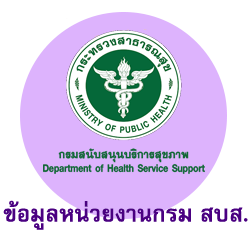THE SERVICE MODEL DEVELOPMENT OF THAI MASSAGE IN HEALTH ESTABLISHMENT, CHIANG MAI PROVINCE
Keywords:
Action research, Service Model development, Thai massage, Health establishmentAbstract
This action research study aimed to develop the service model of Thai massage in the establishment of health based on the Chiang Mai context. This study focused on collaboration among all stakeholders in governmental and non-governmental organizations. The process of Thai massage service model development has been divided into 3 phases: 1) planning was to establish a partnership and to identify the situation and solution for developing the Thai massage service; 2) action was the Thai massage service model development and; 3) evaluating model implementation in 20 health establishments in Chiang Mai province. The data were collected before and after the model implementation by using a health service standard for massage establishment and were analyzed, then, by using the paired t-test.
The findings of this study revealed that the Thai massage service model included three components: 1) good therapist image practice; 2) good massage practice and; 3) good service practice. Coaching by experts was used as a strategy for implementing the model. Results from model implementation showed a significant difference was found on massage service between before and after implementing the model (p < .01). Therefore, this Thai massage service model should be disseminated so that health establishments would have knowledge, skills, and enable evaluate their services that will lead to the development of Thai massage services.
References
Aiumchawe, S., Prompradit, R., Sutawee, B., Suphan, J., & Sooktho, S. (2016). Short term effectsof traditionalThai massagein people with chronic low back pain. Journal of Traditional Thai Medical Research, 2(2), 25-34. (in Thai).
Buttagat, V., Eungpinichpong, W., Chatchawan, U., & Arayawichanon,P. (2012).Therapeuticeffects of traditional Thai massage on pain, muscle tension and anxiety in patients with scapulocostal syndrome: A randomized single-blinded pilot study. Journal of Bodywork and Movement Therapies, 16(1), 57-63
Buttagat, V., Eungpinichpong, W., Chatchawan, U., & Kharmwan, S. (2011). The immediate effects of traditional Thai massage on heart rate variability and stress-related parameters in patients with back pain associated with myofascial trigger points. Journal of Bodywork and Movement Therapies, 15(1), 15-23.
Chaisuvan, C., & Chantachon, S. (2018). Service provider development model inhealthservice of the union of Thai traditional medicine society. Journal of MCU Peace Studies, 6(1), 188-199. (in Thai).
Chantaburee, S. (2016). Opportunity and competitiveness of spa and Thai massage business in Thailand. Kasem Bundit Journal, 17(2), 49-63. (in Thai)
Chiranthanut, N . Hanprasertpong, N . & Teekachunhatean, S. (2014). Thai massage, and Thai herbal compress versus oral ibuprofen in symptomatic treatment of osteoarthritis of the knee: A randomized controlled trial. BioMed Research International, 1-13. http://dx.doi.org/ 10.1155/2014/490512
Department of Health Service Support, Ministry of Public Health. (2016). Strategy for developing Thailand as international center of excellence healthcare (2017-2026). Retrieved from http://203.157.7.120/ fileupload/2560-102.pdf
Foongkol, S. (2006). Action research on work collaboration development: A case study of Yaowalux Witthaya Hang Dong School in Hang Dong district, Chiang Mai province. (Master of Business Administration Thesis, Chiang Mai University). (in Thai).
Jones, R. J., Woods, S. A., & Guillaume, Y. R. F. (2016). The effectiveness of workplace coaching: A meta-analysis of learning and performance outcomes from coaching. Journal of Occupational and Organizational Psychology, 89(2), 249-277
Junead, J., Jamnongchob, A., Wanichakorn, A., & Manirochana, N. (2018).Thestudyon potential ofThai identityinspa businessand traditional Thai massage toward world class health tourism sector. Panyapiwat Journal, 10(2), 1-16. (in Thai).
Kaeoson, S. (2007). Behavior of Thai consumers in selecting health spa services in Chiang Mai province. (Master of Economics Thesis, Chiang Mai University). (in Thai).
Kiawmeesuan, V., Khamsa-ard, S., & Siriwong, P. (2018). Guidelines for potentiaal development of spa business focusonexpectationof foreign tourists in Huahin district, Prachuapkirikhan province. Dusit Thani College Journal, 12(2), 167-181. (in Thai).
Klunpakdee, P. (2017). Standard factors of Thai spa quality award influencing satisfaction on using service towards foreign tourists. (Master of Arts Program in Tourism Management Thesis, Dhurakij Pundit University). (in Thai).
Leesiriwattanagul, S., Charoenkit, K., & Pibanwong, W. (2019). The effect of a Thai massage program on the office syndrome among personnel. Nursing Journal of the Ministry of Public Health, 29(2), 129-141. (in Thai).
Naewboot, J. (2014). Effects of Thai traditional massage to anxiety, depression, and pain level of patients with myofascial pain syndrome at applied Thai traditional medicine clinic, Faculty of Medicine, Thammasart University. (Master of Science Program in Mental Health Thesis, Chulalongkorn University). (in Thai).
Pimsak, B., Tungpisarn, P., & Sivina, S. (2019). A development of strategic implementation model on district health system network, Roi Et province. Journal of Department of Health Service Support, 15(2), 24-32. (in Thai).
Potiopipit, N. (2013).Service marketing mix affecting Thai tourist decision towards selection of Thai massage parlors on Nimmanhaemin Road, Mueang Chiangmai District. (Master of BusinessThesis, Chiang Mai University). (inThai).
Pumthong, G. (2016). Diabetes and blood flow stimulated by traditional Thai massage. Journal of Traditional Thai Medical Research, 2(2), 1-11. (in Thai).
Seedee, R. (2016). Guideline for Thai spa and massage to build business alliances in the ASEAN economic community. Veridian E-Journal, Silpakorn University, 9(3), 756-779. (in Thai).
Soimalun, K., Ramat, C., Khamlangdee, W., & Singthong,P. (2017).TheeffectofThai massage on constipation. Journal of Traditional Thai Medical Research, 3(1), 25-36. (in Thai).
Stringer, E. T. (2007). Action research (3rd ed.). Los Angeles: SAGE.
Tanphong, N. (n.d.). The guideline of service improvement of traditional Thai massage. Retrieved from http://grad.kbu.ac.th/ wp-content/uploads/2014/09/559901803152 ...9%8C.pdf (in Thai).
Thakanun,W., & Huanprapai,P. (2018).Thai massage service behavior in Ratchaburi, Thailand. Proceedings of International Academic Conferences 8810432, International Institute of Social and Economic Sciences.
Downloads
Published
How to Cite
Issue
Section
License
Copyright (c) 2020 Journal of Department of Health Service Support-วารสารวิชาการกรมสนับสนุนบริการสุขภาพ

This work is licensed under a Creative Commons Attribution-NonCommercial-NoDerivatives 4.0 International License.



